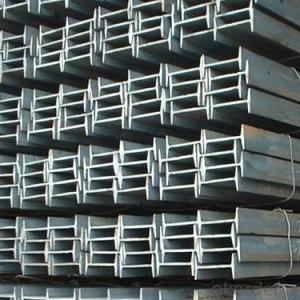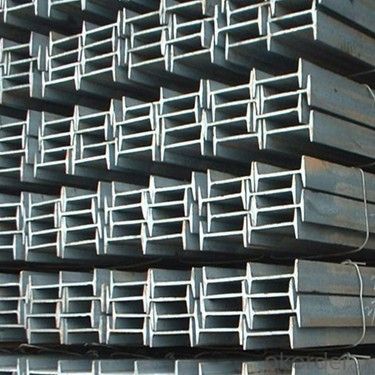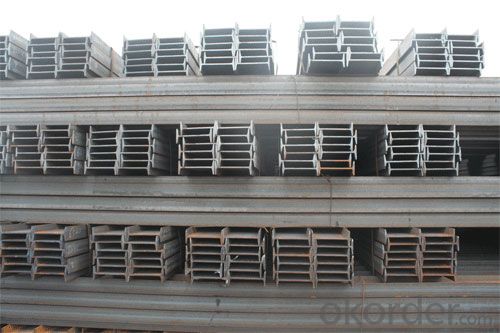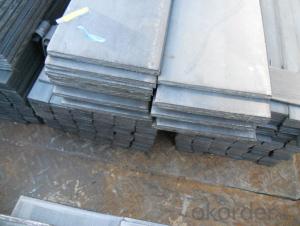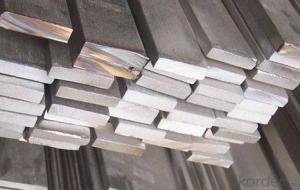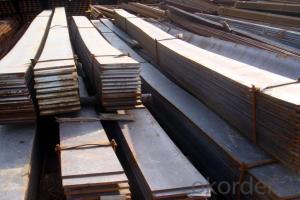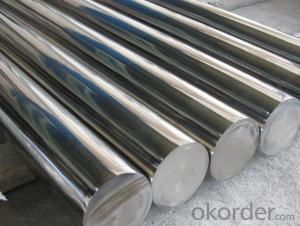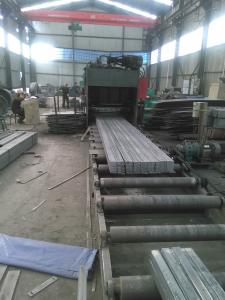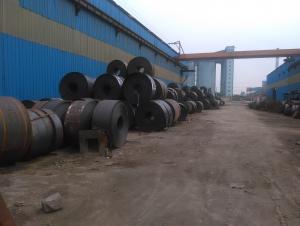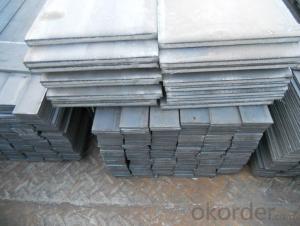Carbon stainless steel flat bar for construction
- Loading Port:
- Tianjin
- Payment Terms:
- TT OR LC
- Min Order Qty:
- 10000 m.t.
- Supply Capability:
- 100000 m.t./month
OKorder Service Pledge
OKorder Financial Service
You Might Also Like
Specification
Product Description:
OKorder is offering carbon stainless steel flat bar for construction at great prices with worldwide shipping. Our supplier is a world-class manufacturer of steel, with our products utilized the world over. OKorder annually supplies products to European, North American and Asian markets. We provide quotations within 24 hours of receiving an inquiry and guarantee competitive prices.
Product Applications:
Carbon stainless steel flat bar are ideal for structural applications and are widely used in the construction of buildings and bridges, and the manufacturing, petrochemical, and transportation industries.
Product Advantages:
OKorder's Steel flat bar are durable, strong, and resist corrosion.
Main Product Features:
1.Cr12Mo1V1 (D2) steel is the wider usd international belong to high carbon and high chromium ledeburite cold work die steel
2.This steel has high hardenability, hardened, abrasion resistance, high temperature oxidation resistance
3.Quenching and polishing after has good anti-rust, heat deformation small,
4.should be the manufacturing requirements of high-precision, long-life cold work die, props and gauges.
5.Grade: D2,1.2379,X160CrMoV12,BD2,XW-42.
Chemical Composition(%)
C | Si | Mn | Cr | S | P | Mo | V | Co | |||||
1.5 | ≤0.60 | ≤0.60 | 12.00 | ≤0.03 | ≤0.03 | 0.85 | ≤1.10 | ≤1.00 | |||||
Dimesions:
Flat Bar | |||||||||||||
Cold Work Tool Steel | Thickness: 20~450mm;Width:200~600mm | Length:2000~6000mm | |||||||||||
Hot Work Tool Steel | Thickness: 20~650mm;Width:200~1200mm | ||||||||||||
Plastic Mold Steel | Thickness: 20~600mm;Width:200~1200mm | ||||||||||||
Round Bar | |||||||||||||
Cold Work Tool Steel | Dia:20~600mm | Length:2000~6000mm | |||||||||||
Hot Work Tool Steel | Dia:20~650mm | ||||||||||||
Plastic Mold Steel | Dia:20~650mm | ||||||||||||
Dimensions can be customized | |||||||||||||
Application:
Suitable for impact and extrusion molds of high output,thread twisting molds,molds for ceramics, molds for electric circuit plates and plastic molds of high output.
We are professional manufacture of tool steel. We can provide various kinds of tool steel and mould steel. If you have any question regarding our products ,please feel free to let us know. We assure you will receive our best attention to your enquiry.


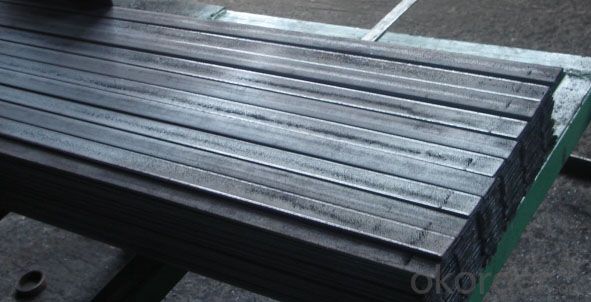
FAQ:
Q1: How do we guarantee the quality of our products?
A1: We have established an advanced quality management system which conducts strict quality tests at every step, from raw materials to the final product. At the same time, we provide extensive follow-up service assurances as required.
Q2: How soon can we receive the product after purchase?
A2: Within three days of placing an order, we will begin production. The specific shipping date is dependent
- Q: Can steel flat bars be bent or formed?
- Yes, steel flat bars can be bent or formed. They have the ability to be shaped into various configurations through processes such as cold bending, hot bending, or using specialized machinery like a press brake.
- Q: Can steel flat bars be hardened or tempered?
- Steel flat bars can indeed undergo hardening or tempering. Hardening entails heating the steel to a specific temperature and rapidly cooling it, typically through water or oil quenching. This procedure alters the steel's molecular structure, resulting in heightened hardness and resistance against wear and deformation. Conversely, tempering takes place after hardening and involves reheating the steel to a lower temperature, followed by slow cooling. This step aids in alleviating internal stresses and enhancing the steel's toughness and ductility, rendering it less brittle and more suitable for certain applications. To achieve desired mechanical properties, both hardening and tempering can be employed on steel flat bars. It is important to note, however, that the particular hardening or tempering method and parameters may differ depending on the type of steel utilized and the desired outcome.
- Q: Can steel flat bars be used for creating handrails or guardrails?
- Handrails or guardrails can indeed be created using steel flat bars. These bars possess remarkable strength and durability, rendering them a fitting material for the construction of handrails and guardrails. With their sleek surface, they provide a pleasant grip and can be effortlessly molded and welded to fulfill precise design specifications. Furthermore, steel flat bars exhibit an exceptional capacity to endure substantial burdens, ensuring the requisite support and safety for handrails and guardrails.
- Q: What are the different sizes available for steel flat bars?
- There is a range of sizes available for steel flat bars to meet different needs and applications. The dimensions of steel flat bars typically vary from 1/8 inch in thickness and 1/2 inch in width to 1 inch in thickness and 12 inches in width. Some commonly used sizes include 1/4 inch in thickness and 1/2 inch in width, 3/8 inch in thickness and 1 inch in width, and 1/2 inch in thickness and 2 inches in width. Moreover, larger sizes of steel flat bars can be obtained, such as 1 inch in thickness and 6 inches or wider in width. The specific size required will depend on the intended purpose of the steel flat bar, whether it is for structural support, fabrication, or general construction. It is advisable to consult a steel supplier or manufacturer to determine the most appropriate size for your particular application.
- Q: Can steel flat bars be hot-dip galvanized?
- Yes, steel flat bars can be hot-dip galvanized. Hot-dip galvanizing is a process where steel is immersed in a bath of molten zinc, which creates a protective coating on the surface of the steel. This coating helps to prevent rust and corrosion, making the steel more durable and long-lasting. Steel flat bars are commonly galvanized to enhance their resistance to environmental factors and increase their lifespan. Hot-dip galvanizing is a widely used method for protecting steel products, including flat bars, from the effects of moisture, chemicals, and other corrosive elements.
- Q: Are steel flat bars commonly used in the manufacturing industry?
- Yes, steel flat bars are commonly used in the manufacturing industry. They are versatile and widely used for various applications such as construction, fabrication, and machinery. Steel flat bars are known for their strength, durability, and cost-effectiveness, making them a popular choice for manufacturers. They can be easily shaped, cut, and welded, allowing for customization and flexibility in design. Additionally, steel flat bars provide stability and support, making them suitable for structural purposes in buildings and infrastructure projects. Overall, steel flat bars play a crucial role in the manufacturing industry due to their many advantages and wide range of applications.
- Q: What is the maximum length of a steel flat bar?
- The length of a steel flat bar can differ based on various factors like the manufacturing process, available resources, and transportation restrictions. Generally, steel flat bars are commonly found in standard lengths between 6 to 12 meters (20 to 40 feet). These lengths are frequently chosen for their convenience in handling, storage, and transportation purposes. In certain situations, it is feasible to produce or obtain longer steel flat bars, but their availability may be limited and necessitate special arrangements for handling and transportation.
- Q: How do steel flat bars contribute to the overall safety of public structures?
- Steel flat bars contribute to the overall safety of public structures in several ways. Firstly, steel flat bars are incredibly strong and durable, making them an ideal material for constructing structural components such as beams, columns, and supports. This strength ensures that public structures can withstand various external forces such as heavy loads, wind, earthquakes, and other natural disasters, reducing the risk of collapse or damage. Additionally, steel flat bars have excellent fire resistance properties. Steel has a high melting point, and unlike other materials like wood or concrete, it does not combust or release toxic fumes when exposed to fire. This fire resistance capability provides an important layer of safety in public structures, allowing occupants to evacuate safely in case of a fire emergency. Moreover, steel flat bars are highly resistant to corrosion, which is vital for structures exposed to harsh weather conditions or environments with high moisture levels. Corrosion weakens the structural integrity of materials over time, leading to potential safety hazards. By using steel flat bars, public structures can withstand corrosion and maintain their strength and safety for an extended period. Another advantage of steel flat bars is their versatility and ease of installation. Steel is a highly adaptable material that can be fabricated into various shapes and sizes according to specific design requirements. This versatility allows engineers to create structures with complex geometries and optimize load-bearing capacities, ensuring the overall stability and safety of the public infrastructure. Lastly, steel flat bars have excellent seismic resistance properties, making them suitable for regions prone to earthquakes. The flexibility and ductility of steel allow it to absorb and dissipate seismic energy, reducing the impact of ground movements on the structure. This capability enhances the safety of public structures by minimizing the risk of structural failure during seismic events. In conclusion, steel flat bars play a crucial role in ensuring the overall safety of public structures. Their strength, fire resistance, corrosion resistance, versatility, and seismic resistance properties contribute to the durability, stability, and integrity of public infrastructure, providing a safe environment for the public to utilize and enjoy.
- Q: Are steel flat bars suitable for outdoor furniture?
- Yes, steel flat bars are suitable for outdoor furniture. Steel is a durable and strong material that can withstand various weather conditions, making it ideal for outdoor use. Steel flat bars offer stability and support to furniture structures, ensuring their longevity and resistance to wear and tear. Additionally, steel can be treated with protective coatings such as powder coating or galvanization to enhance its resistance to rust and corrosion, further extending its lifespan. The versatility of steel also allows for a wide range of design options, making it a popular choice for outdoor furniture.
- Q: Can steel flat bars be heat-treated?
- Yes, steel flat bars can be heat-treated. Heat treatment involves heating the steel to a specific temperature and then cooling it rapidly or slowly to alter its properties such as hardness, strength, and toughness. This process can be used to improve the overall performance and durability of steel flat bars.
Send your message to us
Carbon stainless steel flat bar for construction
- Loading Port:
- Tianjin
- Payment Terms:
- TT OR LC
- Min Order Qty:
- 10000 m.t.
- Supply Capability:
- 100000 m.t./month
OKorder Service Pledge
OKorder Financial Service
Similar products
Hot products
Hot Searches
Related keywords
